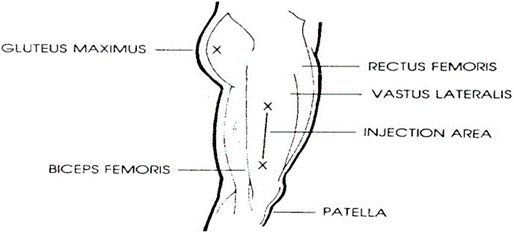The nursing instructor asks the student nurse to identify the intramuscular injection sites. The student correctly identifies the following sites: (SELECT ALL THAT APPLY)
Vastus lateralis
Ventrogluteal
Rectus lateralis
Dorsogluteal
Deltoid
Correct Answer : A,B,E
A. This is located on the lateral side of the thigh. It is a commonly used site for infants, toddlers, and young children, as well as adults who require large-volume injections.

B. This site is located on the hip or gluteal region. It is considered one of the safest and least painful sites for intramuscular injections in adults. It is also used when the volume of medication is larger or when the dorsogluteal site is contraindicated.
E. This site is located on the upper arm, specifically the lateral aspect. It is commonly used for vaccines and medications that require smaller volumes in adults and older children.
C. There is no specific muscle called the "rectus lateralis." It seems to be a combination of the rectus femoris (a muscle in the quadriceps group of the thigh) and the vastus lateralis. However, neither "rectus lateralis" nor "rectus femoris" is commonly used as a distinct injection site in clinical practice.
D. This site is located on the buttocks. Historically, it was a commonly used site for intramuscular injections, but it has fallen out of favor due to the potential risk of injury to the sciatic nerve and superior gluteal artery.
Nursing Test Bank
Naxlex Comprehensive Predictor Exams
Related Questions
Correct Answer is B
Explanation
B. Such an assessment helps in determining the level of assistance the client will need and ensures the safety of both the client and the nurse.
A. Helping the client to sit at the edge of the bed allows them to acclimate to being upright, assess their readiness to stand, and ensures their safety before attempting to walk. However, it is not the priority.
C. After assisting the client to a sitting position at the edge of the bed and assessing their readiness, the nurse can proceed to help the client into a standing position. However, it is not the priority.
D. This option may be necessary if the client requires two-person assistance due to their condition, mobility status, or safety concerns. However, asking for assistance typically comes after assessing the client's readiness and ensuring they are positioned correctly for ambulation.
Correct Answer is B
Explanation
B. pH 7.25, PaCO2 61, HCO3 26
pH is decreased (acidosis).
PaCO2 is elevated (61 mmHg), indicating respiratory acidosis (increased CO2 retention). HCO3 is slightly elevated (26 mEq/L), compensating for the respiratory acidosis.
A. pH 7.45, PaCO2 35, HCO3 22
pH is within normal range (7.35-7.45).
PaCO2 is slightly lower than normal (35 mmHg), indicating mild respiratory alkalosis. HCO3 (bicarbonate) is within normal range (22 mEq/L).
C. pH 7.23, PaCO2 27, HCO3 25
pH is decreased (acidosis).
PaCO2 is lower than normal (27 mmHg), indicating respiratory alkalosis (which is unlikely in the context of morphine overdose with hypoventilation).
HCO3 is within normal range (25 mEq/L).
D. pH 7.54, PaCO2 59, HCO3 26
pH is increased (alkalosis).
PaCO2 is elevated (59 mmHg), indicating respiratory acidosis (consistent with hypoventilation). HCO3 is slightly elevated (26 mEq/L), compensating for the respiratory acidosis.
Whether you are a student looking to ace your exams or a practicing nurse seeking to enhance your expertise , our nursing education contents will empower you with the confidence and competence to make a difference in the lives of patients and become a respected leader in the healthcare field.
Visit Naxlex, invest in your future and unlock endless possibilities with our unparalleled nursing education contents today
Report Wrong Answer on the Current Question
Do you disagree with the answer? If yes, what is your expected answer? Explain.
Kindly be descriptive with the issue you are facing.
